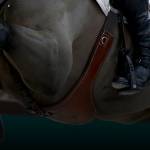WEG 2018: Feeding Show Jumpers

When it comes to managing a top athlete, the question is not only what to feed, but when. Show jumpers and other sport horses that intermittently sprint during competition have a higher demand for a key molecule called adenosine triphosphate (ATP) than horses that compete at more consistent speeds. Research suggests that the composition of the diet and timing of feeding can impact performance by affecting ATP, insulin, and fat levels in the blood.
Researchers recently analyzed the diets of 20 Swiss jumpers and compared them to diet recommendations from published literature to provide new insights into common feeding practices and their effects on show-jumping horses. In addition, they measured the blood levels of various molecules important to exercise (e.g., lactate, fat, insulin, sugar) before and after exercise in 27 jumpers at 71 events.
The results of the feeding questionnaire revealed that, on average, the diets of show jumpers included:
- 6.9 kg (15.2 lb) of roughage per day;
- 3.1 kg (6.8 lb) of concentrates fed in 2 or 3 meals per day;
- On average, the last meal was fed 6 hours, 10 minutes before the start of the first round; and
- 7 horses (35%) had access to hay and water between two performances.
Contrary to some suggestions that a starch-rich (or sugar-rich) diet better supports horses participating in short, intensive work like show jumping, the researchers involved in this study found that jumpers benefited from eating roughage 2 to 4 hours prior to exercise and that feeding concentrates did not have any important influence on blood analyses in this study group.
We’ve seen in previous studies that timing of feeding can affect the horse’s energy level during exercise and can be critical to performance. Feeding a grain meal can have some metabolic consequences that may influence how a horse feels during exercise. After a grain meal, there is a rise in blood glucose that causes insulin to be released. Insulin removes glucose from the bloodstream and introduces it into cells for use or storage.
Blood glucose and insulin levels peak about two hours after a meal. If the horse starts exercising when the insulin level in the bloodstream is high, the horse will use glucose for muscle contractions while insulin is simultaneously storing glucose. The result can be extra low blood glucose, which can cause fatigue in the horse. Therefore, it is advisable to feed a grain meal well before a bout of exercise, at least three or four hours.
The type of energy the horse derives from forages does not have a significant effect on blood glucose and the same effect on fatigue is not usually seen. Therefore, forages can be fed at all times, even leading up to a training session or competition.








